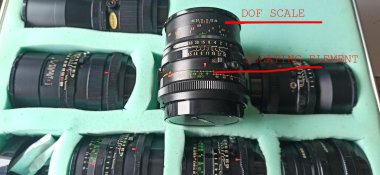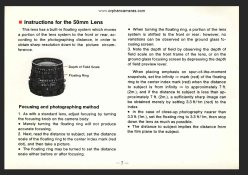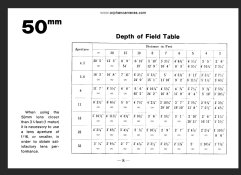Donald Qualls
Subscriber
I recently learned that the Sekor 50mm f/4.5 that I got for my RB67 has a "floating element" -- a user-adjustable internal element or group with a calibrated ring to allow the user to optimize the lens performance for different focus distances.
Then, when the metered chimney finder arrived yesterday, I was testing it with the 250mm f/4.5 and noticed that that lens, also, has a distance calibrated front ring -- is this a floating element control also, or just an unusually sophisticated DOF scale (much easier to read and harder to misread than the one on the side of the bellows)? Even my 90mm f/3.8 has such a scale (though it's operated by a tab, rather than a ring), suggesting it isn't just something brought in with the retrofocus or telefocus designs of the long and wide lenses.
I've heard of floating element lenses -- I just hadn't realized that seemingly all the Sekor lenses for the RB67 have them. Seems like a nice way to get the last little bit of image quality for a primarily studio oriented camera system, or when working on tripod in the field, but much less handy when shooting off tripod (which, admittedly, I don't do much due to the weight of the camera and lenses).
In a lens in helicoid, it would seem obvious to use internal gearing to link these floating elements to the focus, but that's not available for a lens that focuses on a bellows -- is this common with lens designs post-1970, and I just never knew it (because I don't use many newer cameras or lenses)? And how much have I been giving up by not even knowing the setting was there to check when I've shot with my 250mm in the field?
Then, when the metered chimney finder arrived yesterday, I was testing it with the 250mm f/4.5 and noticed that that lens, also, has a distance calibrated front ring -- is this a floating element control also, or just an unusually sophisticated DOF scale (much easier to read and harder to misread than the one on the side of the bellows)? Even my 90mm f/3.8 has such a scale (though it's operated by a tab, rather than a ring), suggesting it isn't just something brought in with the retrofocus or telefocus designs of the long and wide lenses.
I've heard of floating element lenses -- I just hadn't realized that seemingly all the Sekor lenses for the RB67 have them. Seems like a nice way to get the last little bit of image quality for a primarily studio oriented camera system, or when working on tripod in the field, but much less handy when shooting off tripod (which, admittedly, I don't do much due to the weight of the camera and lenses).
In a lens in helicoid, it would seem obvious to use internal gearing to link these floating elements to the focus, but that's not available for a lens that focuses on a bellows -- is this common with lens designs post-1970, and I just never knew it (because I don't use many newer cameras or lenses)? And how much have I been giving up by not even knowing the setting was there to check when I've shot with my 250mm in the field?








 Doing repairs on lenses with coupled second helicoid for the floating element is like doing repairs on zoom lenses.
Doing repairs on lenses with coupled second helicoid for the floating element is like doing repairs on zoom lenses. But I guess it's good that there wasn't a need for this except in the very wide lens. I need to get out with the 50mm soon, the widest I've shot on 35mm is a 35mm lens, and this is about equivalent to a 25-28mm.
But I guess it's good that there wasn't a need for this except in the very wide lens. I need to get out with the 50mm soon, the widest I've shot on 35mm is a 35mm lens, and this is about equivalent to a 25-28mm.





